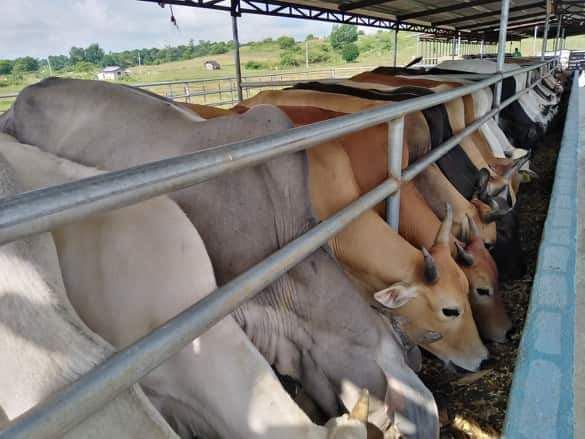Cattle raising in the Philippines. Small-scale cattle production guide
Cattle raising in the Philippines. Small-scale cattle production guide.
In the Philippines, between 75 and 90 percent of the total cattle production are raised in backyard systems. Small scale cattle production offers many benefits.
Raising cattle on the farm helps to promote integration with crops, trees and soil and nutrient cycling is facilitated. Crop residues not suited for human consumption can be converted to food such as milk and meat. Waste in the form of manure can also be incorporated to the soil to fertilize high-value crops. Generally, between one and five heads of cattle are raised by farmers in backyard systems.
The most common limiting factor in backyard cattle production is the poor quality, of feed and or inadequate feed. Grasslands and native pastures only provide fodder for the maintenance of animals and not for improved reproduction or performance. Feed quality, not quantity alone, is critical in cattle feeds and feeding.
Selection of feeder stock
Zeb-breed grade bulls or steers which weigh approximately 180 kg and are between three years of age are preferred as feeder animals. At this age, the rate of growth is faster and more efficient, so that the desired market weight of 275 kg can be easily reached in a shorter fattening period. A daily rate of gain of between 0.5 to 0.8 kg can be expected, especially if enough feeds of sufficient quality can be provided. The health condition of the animal is determined by its bright eyes, soft smooth hair coat and moist muzzle. Avoid blind or lame animals with rough skin and long dull hair. The animals should be square-shaped, with well-sprung ribs and straight legs.
Production practices
Tethering or Staking -This is one of the most common methods of raising cattle by small farmers who have a few head of cattle. The animals need to be moved several times throughout the day.
Unfortunately, the wide- spread mono-cropping and large-scale production of cash crops have resulted in the reduction or loss of pasture areas formerly allotted for tethering of animals.
Stall Feeding or Zero Grazing – Also known as Cut and Cany System. Animals are completely confined in stalls. Feed is carried to them and fed in the stall.
This practice promotes wise use of land. Pasture areas can be divided into a cash crop production area and a forage production area thus income generation can be derived from crops and livestock. Nutrient cycling can also be enhanced
Housing
Cattle sheds are usually constructed using local materials such as bamboo, nipa and coco lumber. A 1.5-sq m area (0.75 m × 2 m) per animal is necessary for shelter. A 5-sq m fenced area for exercise is advisable. If possible, the shed flooring should be cemented or elevated for good drainage and easier removal of manure. The roof of the shed should be at least 3 m high. Feeding troughs and waterers should be provided.
If complete confinement of several animals will be practiced, as in the zero grazing, each stall should measure 1.5 × 4 m which can accommodate the feeder stock during the entire fattening period.
Additional information on feeding fatteners
The primary and most cost-effective source of feed for cattle is quality forage or roughage. Farm wastes such as com stover, rice straw and sugar cane tops are usually given together with some concentrates. Good quality grass usually contains eight percent crude protein on a dry matter basis; growing feeder stock need about 12 percent for normal growth. A grass-legume mixture would be better since legumes contain about 20 percent crude protein and have a high calcium value. On the average, cattle consume feed dry matter (lees water) at a level of two percent of its body weight. The percentage is higher for young animals and decreases as the animal matures. For example, a 300-kg animal is expected to consume about 6 kg dry matter of feed per day or roughly 24 kg fresh forage.
Since feeding roughage may not be adequate to supply the required energy and protein for fattening, it is necessary. to add concentrates in the diet at the rate of 1 to 1.5 percent of the animal body weight. Concentrates can either be formulated and mixed in the farm or purchased off-farm. Molasses, a good source of energy, is usually added to the ration to increase palatability. Rations containing 15-25 percent concentrate and 75-85 percent roughage have been found to be satisfactory in promoting good daily weight gain. One half of the ration should be given in the morning; the other half in the afternoon. The ration to be fed to the animal will also depend on the size of the animal at the time they are purchased and the desired final weight. Ordinary salt (30 to 50 gms/day/head) and good quality water should be provided at all times. Newly purchased feeder stock should be gradually introduced to the concentrate diet.
Do you know that…
* Annually, one head of cattle excretes 60 kilograms Nitrogen, four kilograms Phosphorus and 18 kilograms Potassium.
* A cow reaches puberty at the age of 18 months and has a gestation period of 283 days. Estrous cycle is 18 – 24 days.
* Cattle can be used in transporting farm products to and from markets and to transport fuel, water and goods.
* It takes about 1,000 days to breed and raise cattle to the butchering weight of 400-500 kilograms.
* On an average, Filipinos consume two kilograms of beef per year as the country’s cattle supply drops continuously.https://businessdiary.com.ph/2980/small-scale-cattle-production/#:~:text=In%20the%20Philippines%2C%20between%2075,and%20nutrient%20cycling%20is%20facilitated.
0 Likes0 Replies
Manigo Agri-Business Park Balungao, Pangasinan
Active
Priority Assistance
₱ 4.69 million
For Sale Pre-Selling Single Detached House
3 Bedrooms 2 Bathrooms 116 sqm.
Dagupan Pangasinan
Active
Priority Assistance
₱ 2.83 million
For Sale Foreclosed Single Attached House
2 Bedrooms 1 Bathroom 140 sqm.
Dagupan Pangasinan
Active
Priority Assistance
₱ 500 million
For Sale Ready For Occupancy Beach Property
20 hectares
Bolinao Pangasinan
Active
Priority Assistance
₱ 4.19 million
For Sale Foreclosed Single Attached House
3 Bedrooms 2 Bathrooms 98 sqm.
Santa Barbara Pangasinan
Active
Priority Assistance
₱ 2.66 million
For Sale Residential Condo
Studio 1 Bathroom 19 sqm.
Dagupan Pangasinan
Active
Priority Assistance
₱ 3.40 million
For Sale Pre-Selling Residential Condo
Studio 1 Bathroom 23 sqm.
Dagupan Pangasinan
Active
Priority Assistance
₱ 228 million₱ 3,500/sqm
For Resale Farm Lot
6.5 hectares
Manaoag Pangasinan
Active
In Demand
₱ 3.09 million
For Sale Ready For Occupancy Single Detached House
3 Bedrooms 2 Bathrooms 56 sqm.
Urdaneta Pangasinan
Active
Priority Assistance
₱ 6.71 million
For Sale Pre-Selling Residential Condo
1 Bedroom 1 Bathroom 34 sqm.
Urdaneta Pangasinan
Active
Priority Assistance
₱ 5.90 million
For Sale Duplex House
4 Bedrooms 2 Bathrooms 140 sqm.
San Carlos Pangasinan
Active
Priority Assistance
₱ 280,000₱ 2,800/sqm
For Sale Residential Lot
100 sqm.
Mapandan Pangasinan
Active
Priority Assistance
₱ 1.79 million
For Sale Pre-Selling Residential Condo
Studio 1 Bathroom 19 sqm.
Urdaneta Pangasinan


















